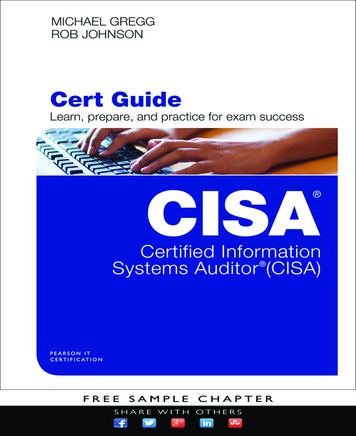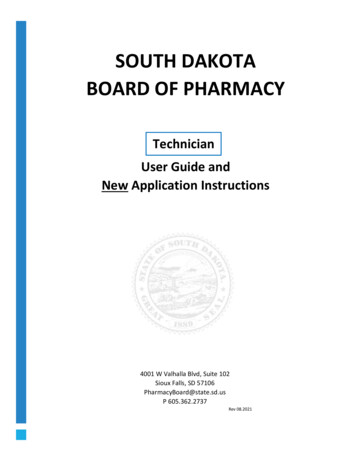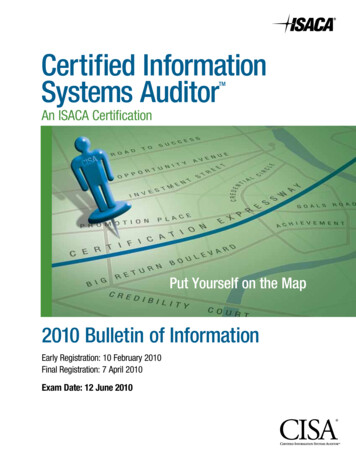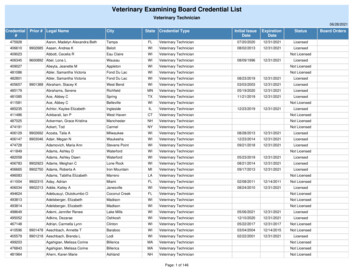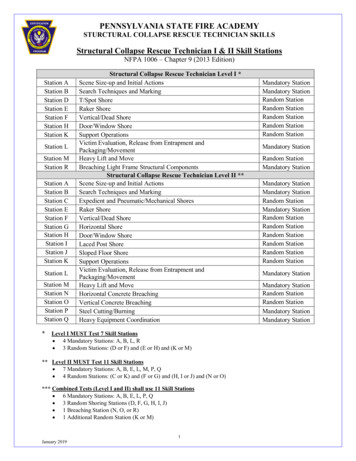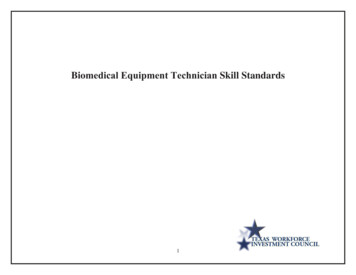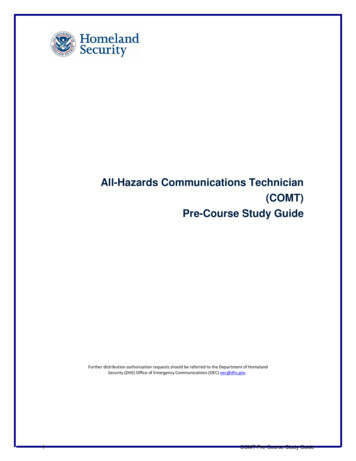
Transcription
All-Hazards Communications Technician(COMT)Pre-Course Study GuideFurther distribution authorization requests should be referred to the Department of HomelandSecurity (DHS) Office of Emergency Communications (OEC) oec@dhs.gov .1COMT Pre-Course Study Guide
TABLE OF CONTENTSINTRODUCTION. 1GUIDED STUDY . 2Study 1: Radio Wave Propagation.4Study 2: Voice versus Data .34Study 3: Voice Communications .40Study 4: Characteristics of Radio Systems.56Study 5: Antennas.66Study 5: Antennas (Continued) .88Study 6: Current Public Safety Systems.104Study 6: Current Public Safety Systems (Continued) .1262COMT Pre-Course Study Guide
INTRODUCTIONThis Study Guide was created so that all students of the All-Hazards CommunicationsTechnician (COMT) course will have the same foundational knowledge. Somestudents’ skills and experience will be above and beyond what is contained in thesepages. Others will be introduced to terms and theories they have not yet experienced.In-class discussion will give students an opportunity to explore further those theoriesthat are new to them. Exercises during the class will then provide an opportunity totest the theories learned. Finally, post-class research and performance as a COMT atincidents and planned events will provide students the opportunity to experiment withand prove the theories in real-world situations.The Department of Homeland Security Office of Emergency Communications (OEC),through a group of public safety practitioners with many years of incidentcommunications experience, developed this course as an introductory course. Itspurpose is to introduce prospective COMTs to the role of the COMT at an incident orplanned event, to introduce the technologies that may be deployed in support of anincident, and to provide resources and tools that a prospective COMT can use to betterunderstand what assets are available locally and plan how those resources might bebrought to bear in times of crisis.This Study Guide is a compilation of information extracted from three sources.The complete documents are available for download from the Public Safety Toolswebsite. Go to: http://www.publicsafetytools.info/start index v2.php Click on “PSLibrary” then “Webview” and search on the title of each individual referencedocument.1. The Federal Emergency Management Agency (FEMA) National UrbanSearch and Rescue Response System Communications Specialist CourseStudent Workbook.12. The U.S. Department of Justice Office of Community Oriented PolicingServices (COPS Office) Law Enforcement Tech Guide for CommunicationsInteroperability: A Guide for Interagency Communications Projects.23. The National Law Enforcement and Corrections Technology Center–RockyMountain Region (NLECTC) Understanding Wireless Communications inPublic Safety: A Guidebook to Technology, Issues, Planning, andManagement.31Federal Emergency Management Agency (FEMA), National Urban Search and Rescue Response SystemCommunications Specialist Course Student Workbook, Volumes 1 and 2, Washington, D.C.: FEMA, U.S.Department of Homeland Security, June 2007. Hereafter, FEMA Student Workbook.2Dan M. Hawkins, Law Enforcement Tech Guide for Communications Interoperability: A Guide for InteragencyCommunications Projects, Washington, D.C.: U.S. Department of Justice Office of Community Oriented PolicingServices, 2006. This publication is available in hard copy at no cost from the COPS Office. px?RID 238 for more information. Hereafter, COPSInteroperability Tech Guide.3Kathy J. Imel and James W. Hart, P.E., Understanding Wireless Communications in Public Safety: AGuidebook to Technology, Issues, Planning and Management, Denver, Colorado: NLECTC–Rocky Mountain,second edition, January 2003. Hereafter, NLECTC Guidebook.3COMT Pre-Course Study Guide
The information you will need to be successful in the All-Hazards COMT course iscontained in specific chapters in these documents and is outlined below; however, ifyou would like to learn more, please feel free to read these documents in theirentirety.During the COMT course, you will be tested on the information provided in these studies.GUIDED STUDYFor your convenience, this Study Guide provides a compilation of excerpts fromthree publications. COMT students are expected to read this Study Guide and befamiliar with its content prior to attending the class.Study 1: Radio Wave PropagationReference Material: FEMA Student Workbook, Volume 2-28, June 2007, Chapter 1.Study 2: Voice versus DataReference Material: NLECTC Guidebook, Chapter 5.Study 3: Voice CommunicationsReference Material: COPS Interoperability Tech Guide, Chapter 16, pages 245-258.Study 4: Characteristics of Radio SystemsReference Material: NLECTC Guidebook, Chapter 6, pages 41-49.Study 5: AntennasReference Material: FEMA Student Workbook, Volume 2-28, June 2007, Chapter 3.Reference Material: NLECTC Guidebook, Chapter 6, pages 50-64.Study 6: Current Public Safety SystemsReference Material: NLECTC Guidebook, Chapter 7.Reference Material: COPS Interoperability Tech Guide, Chapter 16, pages 259-282,and Chapter 17.4COMT Pre-Course Study Guide
Study 1: Radio Wave PropagationReference Material: FEMA Student Workbook, Volume 2-28, June 2007 - Chapter 1Figure 1-1 on page 8 of this document is in error. The following diagram has been corrected andshould be referred to rather than what was published in the FEMA Student Workbook.COMT Pre-Course Study Guide5
National Urban Search and Rescue Response SystemCommunications Specialist CourseCHAPTER 1: RADIO WAVE PROPAGATIONLearning ObjectivesUpon completing this chapter, you will be able to State what radio waves are; List the components of a radio wave and define the terms cycle, frequency, harmonics,period, wavelength, and velocity as applied to radio wave propagation; Compute the wavelength of radio waves; State how radio waves are polarized, vertically and horizontally; State what reflection, refraction, and diffraction are as applied to radio waves; State what influence the Earth's atmosphere has on radio waves and list the differentlayers of the Earth's atmosphere; Identify a ground wave, a sky wave, and state the effects of the ionosphere on the skywave; Describe propagation paths; Describe fading, multipath fading; Describe propagation paths; State how transmission losses affect radio wave propagation; State how electromagnetic interference, man-made/natural interference, and ionosphericdisturbances affect radio wave propagation. State how transmission losses affect radiowave propagation; State what temperature inversion is, how frequency predictions are made, and howweather affects frequency; and State what tropospheric scatter is and how it affects radio wave propagation.Introduction to Wave PropagationOf the many technical subjects that Communication Specialists are expected to know, the oneleast susceptible to change is the theory of wave propagation. The basic principles that enablewaves to be propagated (transmitted) through space are the same today as they were 70 yearsago. One would think, then, that a thorough understanding of these principles is a relativelysimple task. For the electrical engineer or the individual with a natural curiosity for the unknown,it is indeed a simple task. Most technicians, however, tend to view wave propagation assomething complex and confusing, and would just as soon see this chapter completely disappearfrom training manuals. This attitude undoubtedly stems from the fact that wave propagation is aninvisible force that cannot be detected by the sense of sight or touch. Understanding waveJune 20076Workbook Volume 2-1COMT Pre-Course Study Guide
National Urban Search and Rescue Response SystemCommunications Specialist Coursepropagation requires the use of the imagination to visualize the associated concepts and how theyare used in practical application. This manual was developed to help you visualize andunderstand those concepts. Through ample use of illustrations and a step-by-step transition fromthe simple to the complex, we will help you develop a better understanding of wave propagation.In this chapter, we will discuss propagation theory on an introductory level, without going intothe technical details that concern the engineer. However, you must still use thought andimagination to understand the new ideas and concepts as they are presented.To understand radio wave propagation, you must first learn what wave propagation is and someof the basic physics or properties that affect propagation. Many of these properties are commoneveryday occurrences, with which you are already familiar.What is Propagation?Early man was quick to recognize the need to communicate beyond the range of the humanvoice. To satisfy this need, he developed alternate methods of communication, such as handgestures, beating on a hollow log, and smoke signals. Although these methods were effective,they were still greatly limited in range. Eventually, the range limitations were overcome by thedevelopment of courier and postal systems; but there was then a problem of speed. For centuriesthe time required for the delivery of a message depended on the speed of a horse.During the latter part of the 19th century, both distance and time limitations were largelyovercome. The invention of the telegraph made possible instantaneous communication over longwires. Then a short time later, man discovered how to transmit messages in the form of RADIOWAVES.As you will learn in this chapter, radio waves are propagated. PROPAGATION means"movement through a medium." This is most easily illustrated by light rays. When a light isturned on in a darkened room, light rays travel from the light bulb throughout the room. When aflashlight is turned on, light rays also radiate from its bulb, but are focused into a narrow beam.You can use these examples to picture how radio waves propagate. Like the light in the room,radio waves may spread out in all directions. They can also be focused (concentrated) like theflashlight, depending upon the need. Radio waves are a form of radiant energy, similar to lightand heat. Although they can neither be seen nor felt, their presence can be detected through theuse of sensitive measuring devices. The speed at which both forms of waves travel is the same;they both travel at the speed of light.You may wonder why you can see light but not radio waves, which consist of the same form ofenergy as light. The reason is that you can only "see" what your eyes can detect. Your eyes candetect radiant energy only within a fixed range of frequencies. Since the frequencies of radiowaves are below the frequencies your eyes can detect, you cannot see radio waves.The theory of wave propagation that we discuss in this section applies to communicationequipment.Workbook Volume 2-27June 2007COMT Pre-Course Study Guide
National Urban Search and Rescue Response SystemCommunications Specialist CourseElectromagnetic SpectrumLight is one kind of electromagnetic energy. There are many other types, including heat energyand radio energy. The only difference between the various types of electromagnetic energy is thefrequency of their waves (rate of vibration). The term SPECTRUM is used to designate the entirerange of electromagnetic waves arranged in order of their frequencies. The VISIBLESPECTRUM contains only those waves which stimulate the sense of sight. You, as a technician,might be expected to maintain equipment that uses electromagnetic waves within, above, andbelow the visible spectrum.There are neither sharp dividing lines nor gaps in the ELECTROMAGNETIC SPECTRUM.Figure 1-1 illustrates how portions of the electromagnetic spectrum overlap. Notice that only asmall portion of the electromagnetic spectrum contains visible waves, or light, which can be seenby the human eye.Figure 1-1.—Electromagnetic spectrum.June 20078Workbook Volume 2-3COMT Pre-Course Study Guide
National Urban Search and Rescue Response SystemCommunications Specialist CourseElectromagnetic WavesIn general, the same principles and properties of light waves apply to the communicationselectromagnetic waves you are about to study. The electromagnetic field is used to transferenergy (as communications) from point to point. We will introduce the basic ANTENNA as thepropagation source of these electromagnetic waves.The Basic AntennaThe study of antennas and electromagnetic wave propagation is essential to a completeunderstanding of radio communication, radar, loran, and other electronic systems. Figure 1-2shows a simple radio communication system. In the illustration, the transmitter is an electronicdevice that generates radio-frequency energy. The energy travels through a transmission line (wewill discuss this in chapter 3) to an antenna. The antenna converts the energy into radio wavesthat radiate into space from the antenna at the speed of light. The radio waves travel through theatmosphere or space until they are either reflected by an object or absorbed. If another antenna isplaced in the path of the radio waves, it absorbs part of the waves and converts them to energy.This energy travels through another transmission line and is fed to a receiver. From this example,you can see that the requirements for a simple communications system are (1) transmittingequipment, (2) transmission line, (3) transmitting antenna, (4) medium, (5) receiving antenna,and (6) receiving equipment.Figure 1-2.—Simple radio communication system.Workbook Volume 2-49June 2007COMT Pre-Course Study Guide
National Urban Search and Rescue Response SystemCommunications Specialist CourseAn antenna is a conductor or a set of conductors used either to radiate electromagnetic energyinto space or to collect this energy from space. Figure 1-3 shows an antenna. View A is adrawing of an actual antenna; view B is a cut-away view of the antenna; and view C is asimplified diagram of the antenna.Figure 1-24.—Antenna.Radio WavesAn energy wave generated by a transmitter is called a RADIO WAVE. The radio wave radiatedinto space by the transmitting antenna is a very complex form of energy containing both electricand magnetic fields. Because of this combination of fields, radio waves are also referred to asELECTROMAGNETIC RADIATION. This discussion will explain the Earth's atmosphere andits effect on radio waves.NOTE: The term radio wave is not limited to communications equipment alone. The termapplies to all equipment that generates signals in the form of electromagnetic energy.Components of Radio WavesThe basic shape of the wave generated by a transmitter is that of a sine wave. The wave radiatedout into space, however, may or may not retain the characteristics of the sine wave.A sine wave can be one cycle or many cycles. Recall from chapter 1 that the number of cycles ofa sine wave that are completed in 1 second is known as the frequency of the sine wave. Forexample, 60 cycles of ordinary house current occur each second, so house current is said to havea frequency of 60 cycles per second or 60 hertz.The frequencies falling between 3000 hertz (3 kHz) and 300,000,000,000 hertz (300 GHz) arecalled RADIO FREQUENCIES (abbreviated rf) since they are commonly used in radiocommunications. This part of the radio frequency spectrum is divided into bands, each bandbeing 10 times higher in frequency than the one immediately below it. This arrangement servesJune 200710Workbook Volume 2-5COMT Pre-Course Study Guide
National Urban Search and Rescue Response SystemCommunications Specialist Courseas a convenient way to remember the range of each band. The rf bands are shown in table 1-1.The usable radio-frequency range is roughly 10 kilohertz to 100 gigahertz.Table 1-1.—Radio Frequency BandsDESCRIPTIONABBREVIATIONFREQUENCYVery lowVLF3 to 30 KHzLowLF30 to 300 KHzMediumMF300 to 3000 KHzHighHF3 to 30 MHzVery highVHF30 to 300 MHzUltrahighUHF300 to 3000 MHzSuper highSHF3 to 30 GHzExtremely highEHF30 to 300 GHzThe PERIOD of a radio wave is simply the amount of time required for the completion of onefull cycle. If a sine wave has a frequency of 2 hertz, each cycle has a duration, or period, of onehalf second. If the frequency is 10 hertz, the period of each cycle is one-tenth of a second. Sincethe frequency of a radio wave is the number of cycles that are completed in one second, youshould be able to see that as the frequency of a radio wave increases, its period decreases.A wavelength is the space occupied by one full cycle of a radio wave at any given instant.Wavelengths are expressed in meters (1 meter is equal to 3.28 feet). You need to have a goodunderstanding of frequency and wavelength to be able to select the proper antenna(s) for use insuccessful communications.The velocity (or speed) of a radio wave radiated into free space by a transmitting antenna isequal to the speed of light–186,000 miles per second or 300,000,000 meters per second. Becauseof various factors, such as barometric pressure, humidity, molecular content, etc., radio wavestravel inside the Earth's atmosphere at a speed slightly less than the speed of light. Normally, indiscussions of the velocity of radio waves, the velocity referred to is the speed at which radiowaves travel in free space.The frequency of a radio wave has nothing to do with its velocity. A 5-megahertz wave travelsthrough space at the same velocity as a 10-megahertz wave. However, the velocity of radiowaves is an important factor in making wavelength-to-frequency conversions, the subject of ournext discussion.Workbook Volume 2-611June 2007COMT Pre-Course Study Guide
National Urban Search and Rescue Response SystemCommunications Specialist Course Learning Check1. What is the term used to describe the basic frequency of a radio wave?Wavelength-to-Frequency ConversionsRadio waves are often referred to by their wavelength in meters rather than by frequency. Forexample, most people have heard commercial radio stations make announcements similar to thefollowing: "Station WXYZ operating on 240 meters." To tune receiving equipment that iscalibrated by frequency to such a station, you must first convert the designated wavelength to itsequivalent frequency.As discussed earlier, a radio wave travels 300,000,000 meters a second (speed of light);therefore, a radio wave of 1 hertz would have traveled a distance (or wavelength) of 300,000,000meters. Obviously then, if the frequency of the wave is increased to 2 hertz, the wavelength willbe cut in half to 150,000,000 meters. This illustrates the principle that the HIGHER THEFREQUENCY, the SHORTER THE WAVELENGTH.Wavelength-to-frequency conversions of radio waves are really quite simple because wavelengthand frequency are reciprocals: Either one divided into the velocity of a radio wave yields theother. Remember, the formula for wavelength is:The wavelength in meters divided into 300,000,000 yields the frequency of a radio wave in hertz.Likewise, the wavelength divided into 300,000 yields the frequency of a radio wave in kilohertz,and the wavelength divided into 300 yields the frequency in megahertz.Now, let us apply the formula to determine the frequency to which the receiving equipment mustbe tuned to receive station WXYZ operating on 240 meters. Radio wave frequencies arenormally expressed in kilohertz or megahertz.June 200712Workbook Volume 2-7COMT Pre-Course Study Guide
National Urban Search and Rescue Response SystemCommunications Specialist CourseTo find the frequency in hertz, use the formula:To find the frequency in kilohertz, use the formula:To find the frequency in megahertz, use the formula:Workbook Volume 2-813June 2007COMT Pre-Course Study Guide
National Urban Search and Rescue Response SystemCommunications Specialist Course Learning Check2. It is known that WWV operates on a frequency of 10 megahertz. What is the wavelengthof WWV?3. A station is known to operate at 60-meters. What is the frequency of the unknownstation?PolarizationFor maximum absorption of energy from the electromagnetic fields, the receiving antenna mustbe located in the plane of polarization. This places the conductor of the antenna at right angles tothe magnetic lines of force moving through the antenna and parallel to the electric lines, causingmaximum induction.Normally, the plane of polarization of a radio wave is the plane in which the E field propagateswith respect to the Earth. If the E field component of the radiated wave travels in a planeperpendicular to the Earth's surface (vertical), the radiation is said to be VERTICALLYPOLARIZED, as shown in figure 1-4, view A. If the E field propagates in a plane parallel to theEarth's surface (horizontal), the radiation is said to be HORIZONTALLY POLARIZED, asshown in view B.Figure 1-4 Polarization.June 200714Workbook Volume 2-9COMT Pre-Course Study Guide
National Urban Search and Rescue Response SystemCommunications Specialist CourseAtmospheric PropagationWithin the atmosphere, radio waves can be reflected, refracted, and diffracted like light and heatwaves.ReflectionRadio waves may be reflected from various substances or objects they meet during travelbetween the transmitting and receiving sites. The amount of reflection depends on the reflectingmaterial. Smooth metal surfaces of good electrical conductivity are efficient reflectors of radiowaves. The surface of the Earth itself is a fairly good reflector. The radio wave is not reflectedfrom a single point on the reflector but rather from an area on its surface. The size of the arearequired for reflection to take place depends on the wavelength of the radio wave and the angleat which the wave strikes the reflecting substance.When radio waves are reflected from flat surfaces, a phase shift in the alternations of the waveoccurs. Figure 1-5 shows two radio waves being reflected from the Earth's surface. Radio wavesthat keep their phase relationships after reflection normally produce a stronger signal at thereceiving site. Those that are received out of phase produce a weak or fading signal. The shiftingin the phase relationships of reflected radio waves is one of the major reasons for fading. Fadingwill be discussed in more detail later in this chapter.Figure 1-5.—Phase shift of reflected radio waves.RefractionAnother phenomenon common to most radio waves is the bending of the waves as they movefrom one medium into another in which the velocity of propagation is different. This bending ofthe waves is called refraction. For example, suppose you are driving down a smoothly pavedroad at a constant speed and suddenly one wheel goes off onto the soft shoulder. The car tends toveer off to one side. The change of medium, from hard surface to soft shoulder, causes a changeWorkbook Volume 2-1015June 2007COMT Pre-Course Study Guide
National Urban Search and Rescue Response SystemCommunications Specialist Coursein speed or velocity. The tendency is for the car to change direction. This same principle appliesto radio waves as changes occur in the medium through which they are passing. As an example,the radio wave shown in figure 1-6 is traveling through the Earth's atmosphere at a constantspeed. As the wave enters the dense layer of electrically charged ions, the part of the wave thatenters the new medium first travels faster than the parts of the wave that have not yet entered thenew medium. This abrupt increase in velocity of the upper part of the wave causes the wave tobend back toward the Earth. This bending, or change of direction, is always toward the mediumthat has the lower velocity of propagation.Figure 1-6.—Radio wave refraction.Radio waves passing through the atmosphere are affected by certain factors, such as temperature,pressure, humidity, and density. These factors can cause the radio waves to be refracted. Thiseffect will be discussed in greater detail later in this chapter.DiffractionA radio wave that meets an obstacle has a natural tendency to bend around the obstacle asillustrated in figure 1-7. The bending, called diffraction, results in a change of direction of part ofthe wave energy from the normal line-of-sight path. This change makes it possible to receiveenergy around the edges of an obstacle as shown in view A or at some distances below thehighest point of an obstruction, as shown in view B. Although diffracted rf energy usually isweak, it can still be detected by a suitable receiver. The principal effect of diffraction extends theradio range beyond the visible horizon. In certain cases, by using high power and very lowfrequencies, radio waves can be made to encircle the Earth by diffraction.June 200716Workbook Volume 2-11COMT Pre-Course Study Guide
National Urban Search and Rescue Response SystemCommunications Specialist CourseFigure 1-7.—Diffraction around an object. Learning Check4. What is one of the major reasons for the fading of radio waves which have been reflectedfrom a surface?The Effect of the Earth’s Atmosphere on Radio WavesThis discussion of electromagnetic wave propagation is concerned mainly with the propertiesand effects of the medium located between the transmitting antenna and the receiving antenna.While radio waves traveling in free space have little outside influence affecting them, radiowaves traveling within the Earth's atmosphere are affected by varying conditions. The influenceexerted on radio waves by the Earth's atmosphere adds many new factors to complicate what atfirst seems to be a relatively simple problem. These complications are because of a lack ofuniformity within the Earth's atmosphere. Atmospheric conditions vary with changes in height,geographical location, and even with changes in time (day, night, season, year). A knowledge ofthe composition of the Earth's atmosphere is extremely important for understanding wavepropagation.The Earth's atmosphere is divided into three separate regions, or layers. They are theTROPOSPHERE, the STRATOSPHERE, and the IONOSPHERE. The layers of the atmosphereare illustrated in figure1-8.Workbook Volume 2-1217June 2007COMT Pre-Course Study Guide
National Urban Search and Rescue Response SystemCommunications Specialist CourseFigure 1-8—Layers of the earth's atmosphere.TroposphereThe troposphere is the portion of the Earth's atmosphere that extends from the surface of theEarth to a height of about 3.7 miles (6 km) at the North Pole or the South Pole and 11.2 miles (18km) at the equator. Virtually all weather phenomena take place in the troposphere. Thetemperature in this region decreases rapidly with altitude, clouds form, and there may be muchturbulence because of variations in temperature, density, and pressure. These conditions have agreat effect on the propagation of radio waves, which will be explained later in this chapter.StratosphereThe stratosphere is located between the troposphere and the ionosphere. The temperaturethroughout this region is considered to be almost constant and there is little water vapor present.The stratosphere has relatively little effect on radio waves because it is a relatively calm regionwith little or no temperature changes.IonosphereThe ionosphere extends upward from about 31.1 miles (50 km) to a height of about 250 miles(402 km). It contains four cloud-like layers of electrically charged ions, which enable radiowaves to be propagated to great distances around the Earth. This is the most important region ofthe atmosphere for long distance point-to-point communications.June 200718Workbook Volume 2-13COMT Pre-Course Study Guide
National Urban Search and Rescue Response SystemCommunications Specialist Course Learning Check5. What are the three layers of the atmosphere?6. Which layer of the atmosphere has relatively little effect on radio waves?Radio Wave TransmissionThere are two principal ways in which electromagnetic (radio) energy travels from a transmittingantenna to a receiving antenna. One way is by GROUND WAVES and the other is by SKYWAVES. Ground waves are radio waves that travel near the surface of the Earth (surface andspace waves). Sky waves are radio waves that are reflected back to Earth from the ionosphere.(See figure 1-9.)Figure 1-9.—Ground waves and sky waves.Ground WavesThe ground wave is actually composed of two separate component waves. These are known asthe SURFACE WAVE and the SPACE WAVE (fig. 1-9). The determining factor in whether aWorkbook Volume 2-1419June 2007COMT Pre-Course Study Guide
National Urban Search and Rescue Response SystemCommunications Specialist Courseground wave component is classified as a space wave or a surface wave is simple. A surfacewave travels along the surface of the Earth. A space wave travels over the surface.SURFACE WAVE.—The surface wave reaches the receiving site by traveling along the surfaceof the ground as shown in figure 1-10. A surface wave can follow the contours of the Earthbecause of the process of diffraction. When a surface wave meets an object and the dimensionsof the object do not exce
When a light is turned on in a darkened room, light rays travel from the light bulb throughout the room. When a flashlight is turned on, light rays also radiate from its bulb, but are focused into a narrow beam. You can use these examples to picture how radio waves propagate. Like the light in the room, radio
